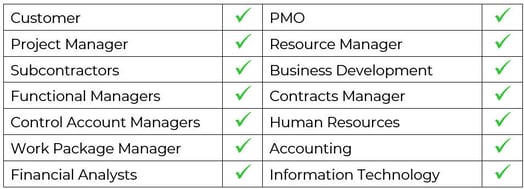The Characteristics of an Adequate Project Budget
A project budget is what a project based organization believes is financially achievable. The budget is a target, and becomes A commitment to action.
What is a Project Budget?
A project budget is what a project based organization believes is financially achievable. The budget is a target which the organization sets for itself, and becomes management’s commitment to action.
Establishing a comprehensive and realistic project budget is rarely a simple task. After all, how do you accurately predict and outline all the moving parts that are required for project success—such as resources, billable hours, and additional expenses—and allot enough money for each of these?
An added challenge is that many of these necessary elements will change before the project reaches completion. The project may take longer than expected, a staff member involved with the project may leave the company, costly errors may need to be remedied, and more.
Every project should have a performance management baseline (PMB) that becomes the basis for variance analysis to plan (Budget–Actuals). The budget is a living and breathing document and should be adjusted as scope changes. If the budget is out-of-date, it will not provide the metrics needed to analyze variances.
What Makes a Great Project Budget?
How do you accomplish all this in your project budget? How do you anticipate all the potential changes and errors that will need to be fixed? While nobody can see the future, there are a few key qualities you can use to create your budget so that it can best adapt to any scenario. The characteristics of an adequate budget are:
- All scope is included—Budgeting tools have user-defined-fields (UDFs) so you can track the SOW or IMP references, ensuring you have all the scope budgeted. Scope comprehension is a big challenge.
- Correlated directly to the WBS which serves as a foundational structure for reporting on the project.
- Correlated directly to the schedule. The schedule also has a PMB and the schedule and the budget should correlate as far as time periods and resources.
- Time phased through the life of the project. The best practice would have the budget broken out at a minimum by month but could be done by week. The units (month or week) needed are driven by the nature of the business.
- The baseline assumptions are current, and changes are included as required. You want this to be a current representation of the work you are to accomplish.
Who influences the project budget?

How Unanet’s Budgeting & Forecasting Software Can Help
Is your team struggling to create a realistic, comprehensive budget that can adapt to the unknown? Budgeting and forecasting software can make establishing the project budget much easier. This software has quite a few benefits:
- Streamline project reporting by offering managers insight into true margin
- Provide capability for planners and project managers to budget using indirect rates
- Expedite real-time information and decision-making
- Forecast direct, indirect charges, and revenues
- Integrate Budgeting and Forecasting data with workforce assignment and actuals labor and expenses
- Achieve effective resource utilization and improved service levels, with lower overhead
- Understand capacity, revenue, cost, and work schedules
- Identify and load level overbooked resources
Unanet offers budgeting and forecasting software for project based organizations to ensure their projects stay on track and they can reach their financial goals. Our software has helped over 2,000 customers stay on budget while achieving project success. Learn how we can make this happen for you in our ebook, Selecting an ERP for Professional Services Organizations.